Page 3 of 252
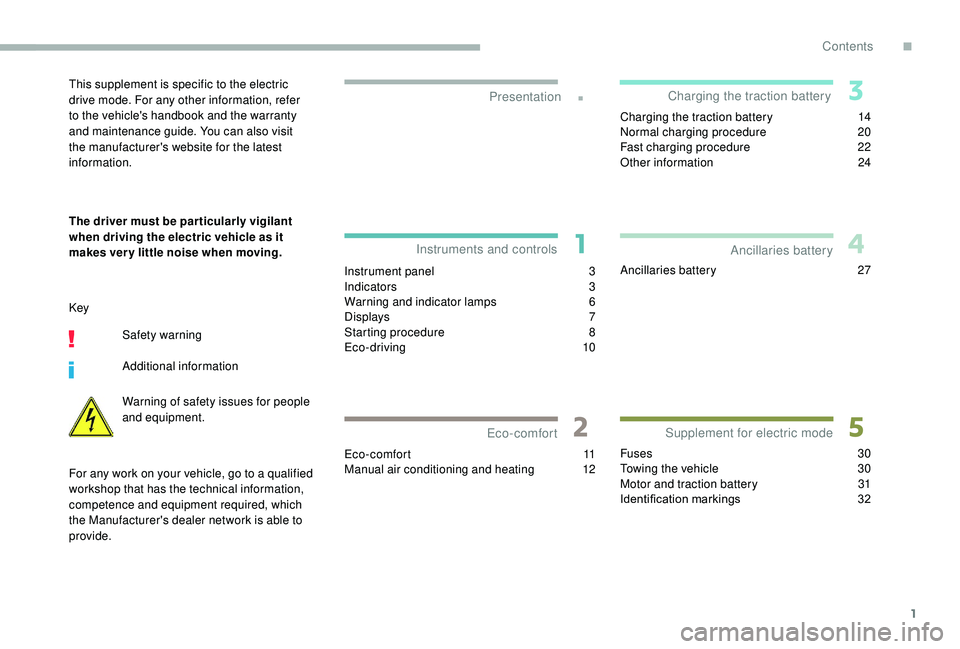
1
.
Instrument panel 3
I ndicators 3
Warning and indicator lamps
6
D
isplays
7
Starting procedure
8
E
co-driving
10
Eco-comfort
11
Manual air conditioning and heating
1
2Charging the traction battery
1
4
Normal charging procedure
2
0
Fast charging procedure
2
2
Other information
2
4
Ancillaries battery 2 7
Fuses
30
Towing the vehicle
3
0
Motor and traction battery
3
1
Identification markings
3
2
Presentation
Instruments and controls
Eco-comfort Charging the traction battery
Supplement for electric mode Ancillaries batteryThis supplement is specific to the electric
drive mode. For any other information, refer
to the vehicle's handbook and the warranty
and maintenance guide. You can also visit
the manufacturer's website for the latest
information.
The driver must be par ticularly vigilant
when driving the electric vehicle as it
makes ver y little noise when moving.
Key
Safety warning
Additional information
Warning of safety issues for people
and equipment.
For any work on your vehicle, go to a qualified
workshop that has the technical information,
competence and equipment required, which
the Manufacturer's dealer network is able to
provide.
Contents
.
Contents
Page 4 of 252
2
Electrical system
1.Normal charging socket
1. Normal charging socket
2. 300
Volt electrical system
3. 12
Volt ancillaries battery
4. Traction battery
5. Fast charging socket
Instruments and controls
1.Instrument panel
2. Display screens
3. Drive selector
Presentation
Page 8 of 252
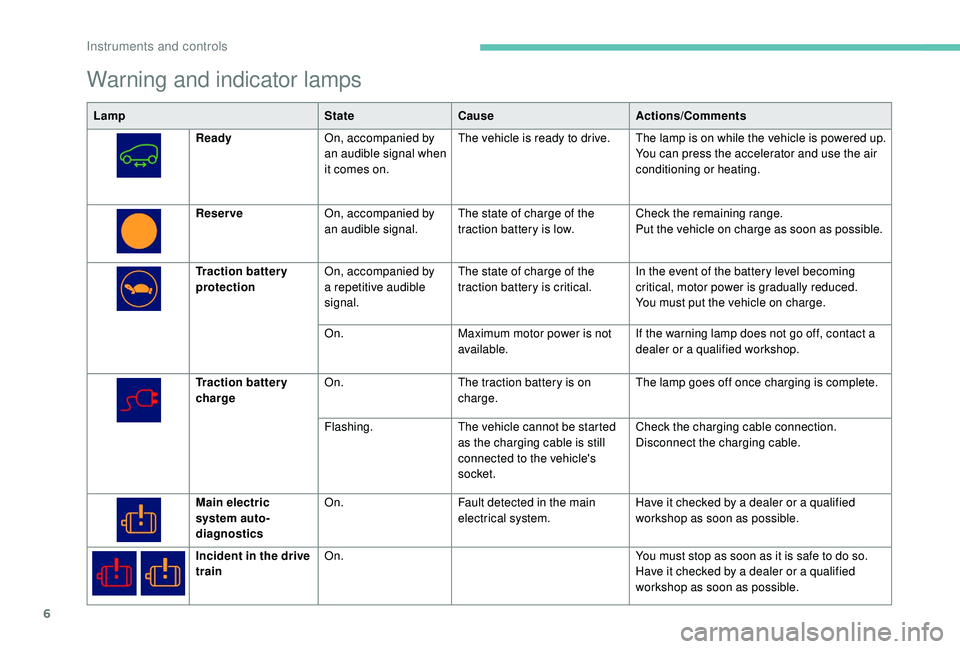
6
Warning and indicator lamps
LampStateCause Actions/Comments
Ready On, accompanied by
an audible signal when
it comes on. The vehicle is ready to drive. The lamp is on while the vehicle is powered up.
You can press the accelerator and use the air
conditioning or heating.
Reser ve On, accompanied by
an audible signal. The state of charge of the
traction battery is low. Check the remaining range.
Put the vehicle on charge as soon as possible.
Traction battery
protection On, accompanied by
a repetitive audible
signal. The state of charge of the
traction battery is critical.
In the event of the battery level becoming
critical, motor power is gradually reduced.
You must put the vehicle on charge.
On. Maximum motor power is not
available. If the warning lamp does not go off, contact a
dealer or a qualified workshop.
Traction battery
charge On.
The traction battery is on
charge. The lamp goes off once charging is complete.
Flashing. The vehicle cannot be started
as the charging cable is still
connected to the vehicle's
socket. Check the charging cable connection.
Disconnect the charging cable.
Main electric
system auto-
diagnostics On.
Fault detected in the main
electrical system. Have it checked by a dealer or a qualified
workshop as soon as possible.
Incident in the drive
train On.
You must stop as soon as it is safe to do so.
Have it checked by a dealer or a qualified
workshop as soon as possible.
Instruments and controls
Page 16 of 252
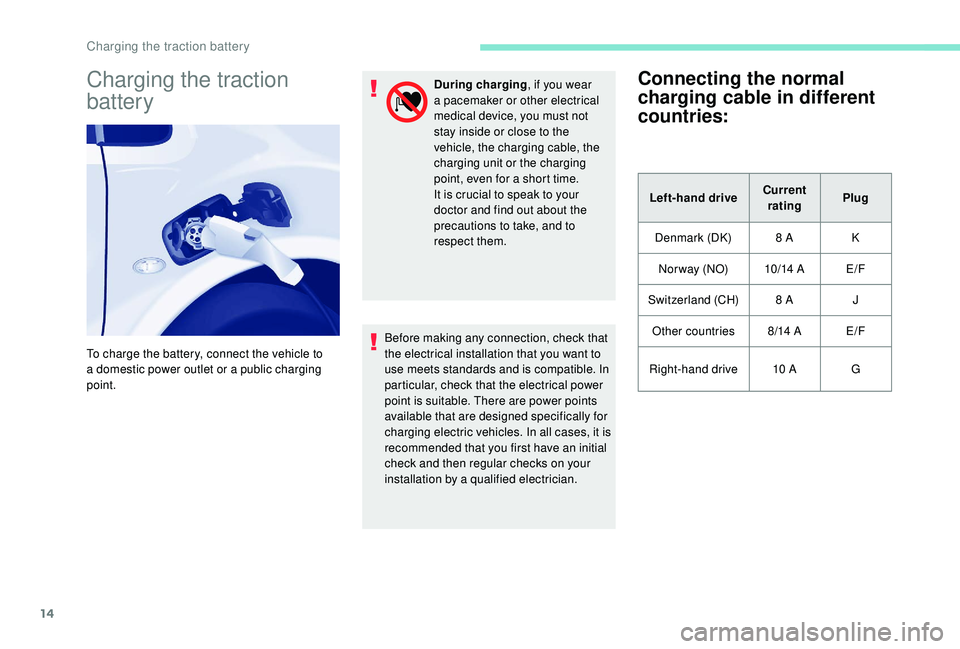
14
Charging the traction
battery
To charge the battery, connect the vehicle to
a domestic power outlet or a public charging
point.During charging
, if you wear
a pacemaker or other electrical
medical device, you must not
stay inside or close to the
vehicle, the charging cable, the
charging unit or the charging
point, even for a short time.
It is crucial to speak to your
doctor and find out about the
precautions to take, and to
respect them.
Before making any connection, check that
the electrical installation that you want to
use meets standards and is compatible. In
particular, check that the electrical power
point is suitable. There are power points
available that are designed specifically for
charging electric vehicles. In all cases, it is
recommended that you first have an initial
check and then regular checks on your
installation by a qualified electrician.
Connecting the normal
charging cable in different
countries:
Left-hand drive Current
rating Plug
Denmark (DK) 8
A K
Nor way (NO) 10/14
AE/F
Switzerland (CH) 8
AJ
Other countries 8/14
AE/F
Right-hand drive 10
AG
Charging the traction battery
Page 17 of 252
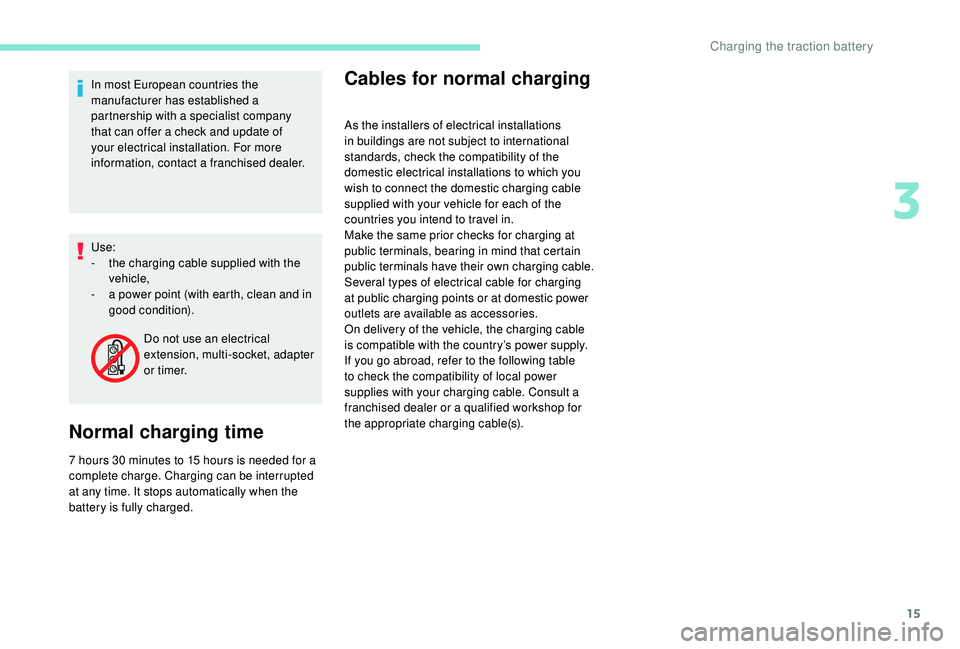
15
In most European countries the
manufacturer has established a
partnership with a specialist company
that can offer a check and update of
your electrical installation. For more
information, contact a franchised dealer.
Use:
-
t
he charging cable supplied with the
vehicle,
-
a p
ower point (with earth, clean and in
good condition).
Normal charging time
7 hours 30 minutes to 15 hours is needed for a
c omplete charge. Charging can be interrupted
at any time. It stops automatically when the
battery is fully charged.
Cables for normal charging
As the installers of electrical installations
in buildings are not subject to international
standards, check the compatibility of the
domestic electrical installations to which you
wish to connect the domestic charging cable
supplied with your vehicle for each of the
countries you intend to travel in.
Make the same prior checks for charging at
public terminals, bearing in mind that certain
public terminals have their own charging cable.
Several types of electrical cable for charging
at public charging points or at domestic power
outlets are available as accessories.
On delivery of the vehicle, the charging cable
is compatible with the country’s power supply.
If you go abroad, refer to the following table
to check the compatibility of local power
supplies with your charging cable. Consult a
franchised dealer or a qualified workshop for
the appropriate charging cable(s).
Do not use an electrical
extension, multi-socket, adapter
or timer.
3
Charging the traction battery
Page 18 of 252
16
Domestic socketMode 3 – Type 2 socketMode 3 – Type 3 socket
"Mode 2" cable (supplied with your vehicle) "Mode 3
– Type 2" cable
(available as an accessory) "Mode 3
– Type 3" cable
(available as an accessory)
Some public terminals have their own charging cable.
In this case, use the cable supplied.
The charge will be limited to max. 16
A in mode 3, regardless of the power of the charging point. For more information on charging durations, refer
to the Motor and main battery section.
Charging the traction battery
Page 19 of 252
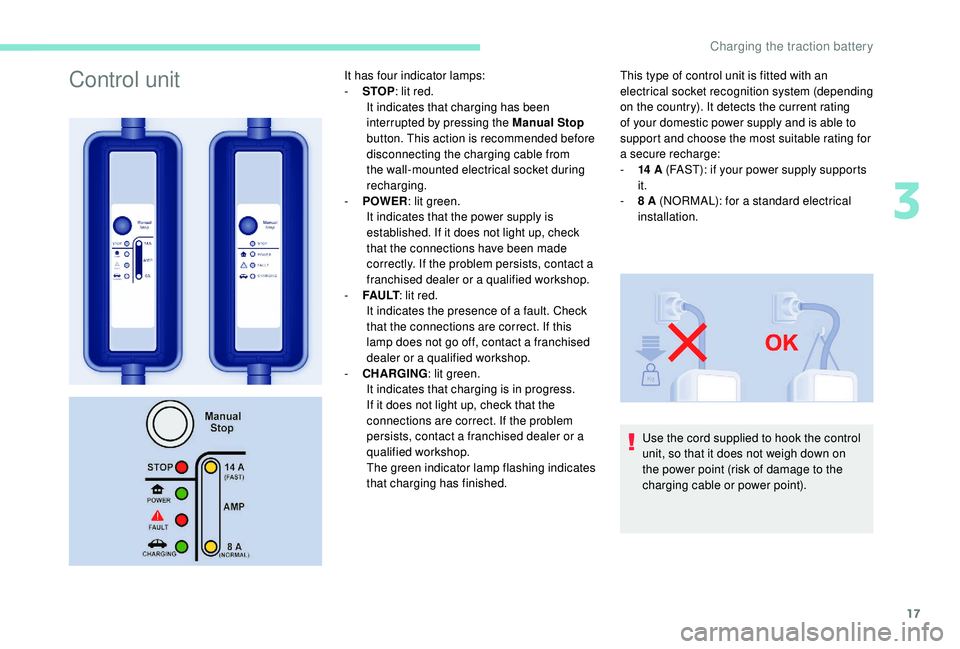
17
Control unitIt has four indicator lamps:
- S TOP: lit red.
It indicates that charging has been
interrupted by pressing the Manual Stop
button. This action is recommended before
disconnecting the charging cable from
the wall-mounted electrical socket during
recharging.
-
P
OWER : lit green.
It indicates that the power supply is
established. If it does not light up, check
that the connections have been made
correctly. If the problem persists, contact a
franchised dealer or a qualified workshop.
-
F
A U LT : lit red.
It indicates the presence of a fault. Check
that the connections are correct. If this
lamp does not go off, contact a franchised
dealer or a qualified workshop.
-
C
HARGING : lit green.
It indicates that charging is in progress.
If it does not light up, check that the
connections are correct. If the problem
persists, contact a franchised dealer or a
qualified workshop.
The green indicator lamp flashing indicates
that charging has finished. This type of control unit is fitted with an
electrical socket recognition system (depending
on the country). It detects the current rating
of your domestic power supply and is able to
support and choose the most suitable rating for
a secure recharge:
-
14
A (FAST): if your power supply supports
it.
-
8
A (NORMAL): for a standard electrical
installation.
Use the cord supplied to hook the control
unit, so that it does not weigh down on
the power point (risk of damage to the
charging cable or power point).
3
Charging the traction battery
Page 20 of 252
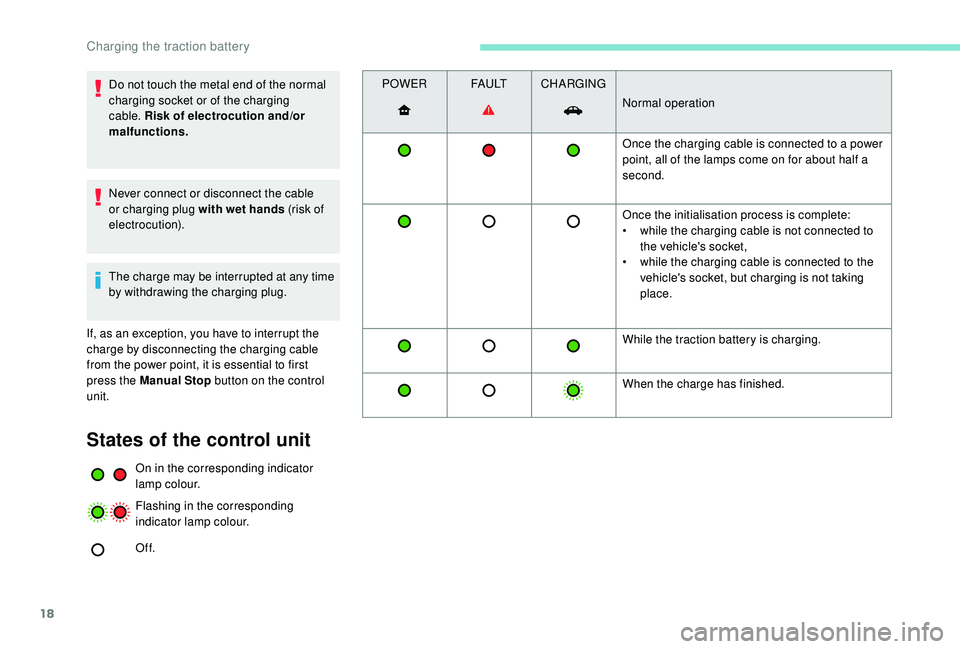
18
Do not touch the metal end of the normal
charging socket or of the charging
cable. Risk of electrocution and/or
malfunctions.
Never connect or disconnect the cable
or charging plug with wet hands (risk of
electrocution).
The charge may be interrupted at any time
by withdrawing the charging plug.
If, as an exception, you have to interrupt the
charge by disconnecting the charging cable
from the power point, it is essential to first
press the Manual Stop button on the control
unit.
States of the control unit
On in the corresponding indicator
lamp colour.
Flashing in the corresponding
indicator lamp colour.
Of f. POWER
FA U LTCHARGING
Normal operation
Once the charging cable is connected to a power
point, all of the lamps come on for about half a
second.
Once the initialisation process is complete:
•
w
hile the charging cable is not connected to
the vehicle's socket,
•
w
hile the charging cable is connected to the
vehicle's socket, but charging is not taking
place.
While the traction battery is charging.
When the charge has finished.
Charging the traction battery